The Reverse Creaming Method for Cakes
Introducing Reverse Creaming also know as Two Stage Creaming.
This is the first in a series of 7 “Cake Batter” classes. Over the course of the series we’ll test how changes to cake batter mixing technique and ingredients can alter a cake’s taste and texture.
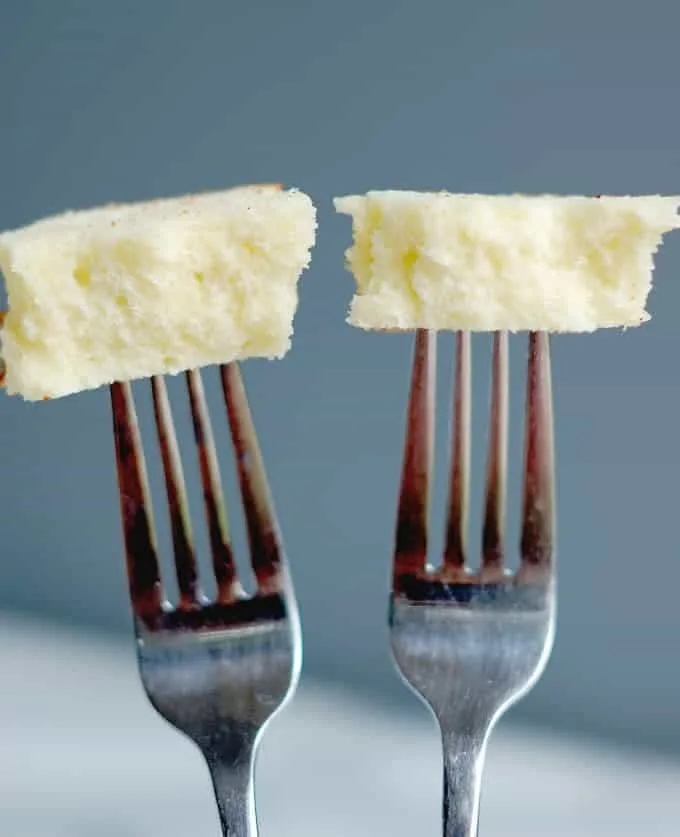
We’ll work with the original pound cake as our test recipe for the “Cake Batter” classes. Pound cake is a great tool for our purposes precisely because it’s a simple recipe with just 4 ingredients.
Pound cake got it’s name based on the original formula of 1 pound each of butter, sugar, eggs and flour. It’s called “quatre-quarts” (four-fourths) by the French.
For our science of cake batter series we’ll look at the role each ingredient plays in the batter. But first we’ll look at two cake batter mixing methods.
Traditional Creaming vs. Reverse Creaming
When I was in culinary school, our first lesson in the “cakes” section was the basic pound cake. Not only did we have to use the original “quatre quarts” recipe, we were required to cream the butter and sugar with a wooden spoon, by hand.
At the time it seemed a little ridiculous. We knew we’d never actually mix a pound cake by hand, especially in a pro kitchen.
But the exercise did reinforce how important technique is, not only for pound cake but for all baking.
What is the creaming method?
The traditional creaming method starts by beating together the butter and sugar. The sharp edges of the sugar crystals cut through the butter to create lots of little air bubbles. The eggs are added one at a time and the flour is added last.
As soon as the flour is added gluten, the protein in the flour that gives baked goods their structure, will start to form. As the cake bakes the air bubbles trapped in the butter will expand in the heat of the oven producing, in theory, a light and airy cake.
What is Reverse Creaming?
Reverse creaming, aka two-stage creaming, is an alternate technique used by many bakers (including me). Reverse creaming starts by beating together the flour, sugar and butter.
Gluten won’t start to form until the flour comes in contact with water (in the egg whites). Coating the flour molecules with butterfat before the eggs are added creates a barrier which slows the formation of gluten. Reverse creaming should, in theory, make a cake with a more tender and velvety texture.
Cake test – creaming versus reverse creaming
One way to compare mixing techniques is to run side-by-side tests. For each test I mixed one batch using the traditional creaming method and one batch using the reverse creaming method.
Each batch of cake contained exactly 8 ounces each of cake flour, granulated sugar, unsalted butter and eggs. The butter and eggs were at ideal room temperature, between 65-70°F.

- All ingredients were at ideal room temperature, about 65°-70°F.
- All cakes were baked in identical 9”x 5” loaf pans at 325°F in a convection oven.
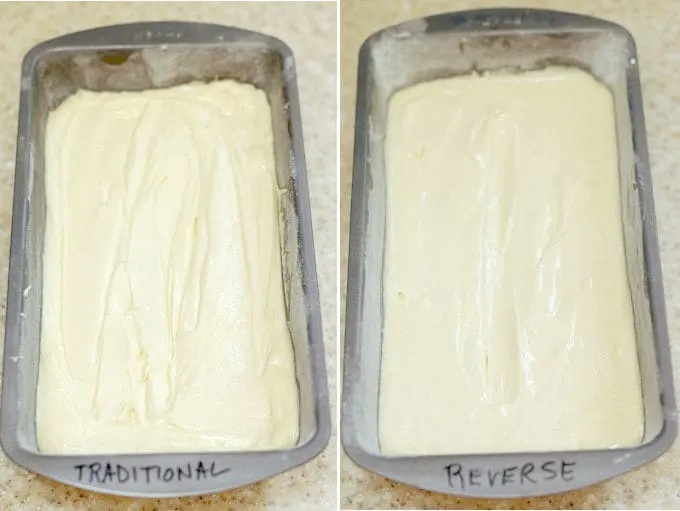
- The cake batters look similar going into the oven.
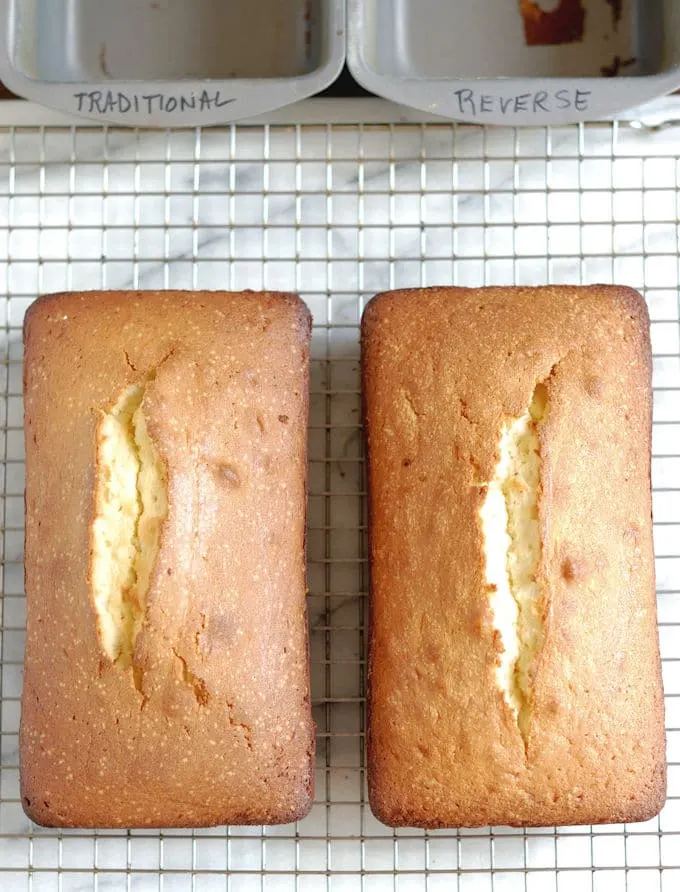
- The crusts on the cakes had slightly different texture.
Creaming vs. Reverse Creaming test results
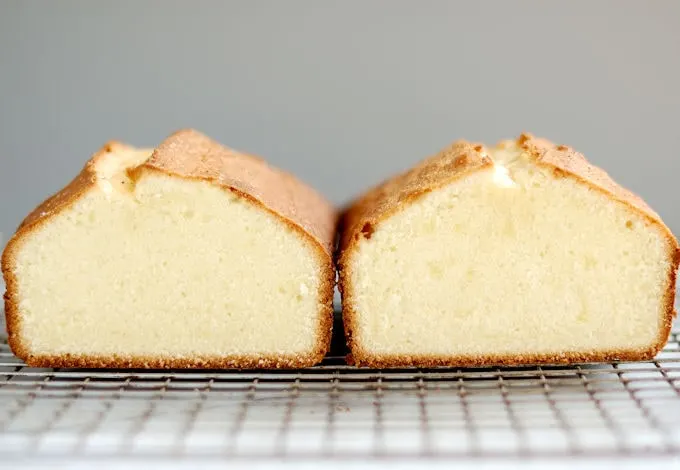
- At first glance, the cakes made with the different mixing methods looked very similar, but once I cut and tasted the cakes the differences became apparent.
- The cake made with the traditional creaming method had a very tight crumb and contained a few pockets of air. The cake was a little chewy with a slightly bouncy texture. I pinched a piece of the cake between my fingers and it held together a moment before breaking up.
- The cake made with the reverse method also had a tight crumb, but it was very consistent with no air pockets. The texture was softer and more tender. When I pinched a piece of that cake between my fingers it broke apart more easily.
Which is better, creaming or reverse creaming?
In tests using the exact same ingredients, a cake made with the reverse creaming method was softer and more tender. Which is why reverse creaming is my preferred mixing method.
Other cake batter classes:
Next up: Cake Batter Class #2 will explore how adding salt, flavorings and leavening can improve on the basic pound cake recipe.
- The function of flour in cake batter
- The function of eggs in cake batter
- The function of sugar in cake batter
- The function of fat in cake batter
- The Cake recipe formula
When we’re done experimenting with all the ingredients for this “cake batter” course, we’ll use all we’ve learned to create Pound Cake Perfection.

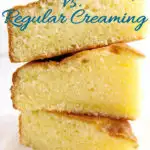
Hi Eileen
That’s so amazing and thank you very much for sharing. I’m wondering of baking to get smooth and moist on the surface (no bake and crust).
Could you please advice
Well,this recipe will always get a bit of a crust because of the whipped egg whites in the batter. Some of the meringue does migrate to the top of the cake and bakes into a crust. Personally, I always trim off the brown edges so I don’t mind if it has a crust. Cake baking strips help keep the cake level.
Hello, I don’t know how I missed this wonderful website. I just knew about it yesterday and I can’t get my eyes of it. Whenever I have few free minutes I jump here.
I have tried the reverse method before with amazing results.. thank you so much for sharing, I will read about them all.
Thanks
Thank you so much, Hala!! That’s so nice of you.
Oh goodness! I’m so grateful for the course. Thanks! I just finished baking the honey vanilla pound cake which had a link to the course and the cakes are sooooooooo good. I got a 4thumbs up from my husband (hands and feet) I have and am learning a lot. Thanks again.
I’m glad you liked the honey pound cake. It’s such a pretty color and it tastes so good.
Hi, Jen. I think it’s actually the cake made with the traditional creaming method that has the little white specks (the cake on the left in the photos). Honestly, I never noticed the specks until I was editing the photos. I’m not 100% sure what that’s from. When I mixed the batter using the traditional creaming method the batter became curdled looking when the eggs were added. The specks may have something to do with that batter not being completely emulsified, but that’s just a guess. Getting a nicely emulsified batter is one of the reasons I put extra egg yolks in the final recipe.
Thanks for reading. I hope it’s helpful.
Hi Eileen, thanks for doing this series of cake batter class. I learnt and am learning a lot from your post, especially the Science behind cakes.
The crust of the cake from the reverse creaming method have lots of white specks compared to the traditional creaming method. Why is that so? I do agree that the texture of the cake from the reverse method is more tender and moist compared to the traditional method.
Thanks again for being so generous with your knowledge.